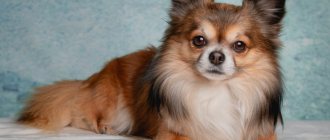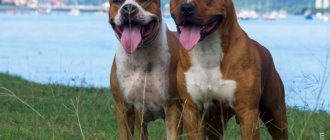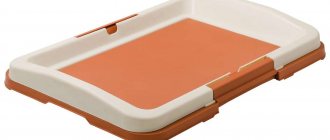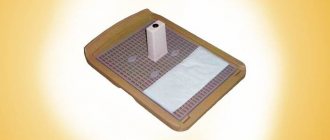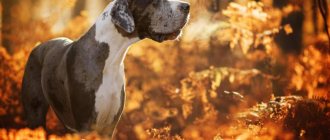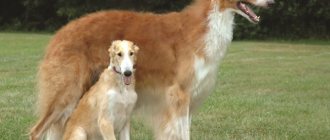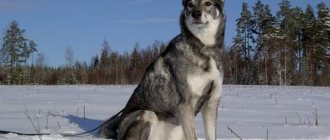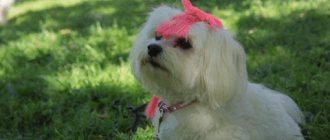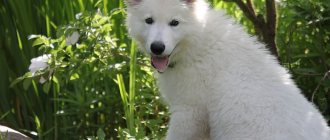Pointing (gun) dogs are hunting dogs with a keen sense of smell, descended from ancient Western and Southern European hounds, which were used to hunt birds with a gun. They retained behavioral traits similar to their ancestors, although during the breeding process they acquired specific features, in particular, freezing in a beautiful stance when they detect game birds.
The vast majority of cops have a medium body size, a lean figure, a wedge-shaped head with floppy ears. They have all kinds of coat lengths and colors. This is a very large group of dogs, so we will consider only the pointers, the most common in Russia.
English pointer
- Height: from 53 to 70 cm
- Weight: from 16 to 34 kg
- Life expectancy: 12-17 years
- Personality: annoying, balanced, friendly, loyal, active
The English Pointer combines athletic grace and strength with a lean, muscular body, alert expression and noble bearing. The gait is smooth and powerful, with their heads held high and their nostrils flared, allowing them to travel long distances in search of airborne scents. The English Pointer's thick coat is short and dense, giving it a streamlined appearance. Pointers tend to hold their tail upright when they find prey.
The earliest pointers were used in the seventeenth century not to guide bird hunters, but to locate hares, which greyhounds were then released to pursue. When bird shooting became popular in the eighteenth century, the English Pointer found its place as a skilled detector of game birds . It found birds, indicated their location, and remained motionless until the hunter was ready to shoot—a process that was somewhat slow with older flintlocks.
Did you know that early pointers probably had genes from the most talented hunting breeds of their time: greyhounds, foxhounds, bloodhounds and setting spaniels. After the War of the Spanish Succession (1713), British Army officers returned home with sturdy Spanish Pointers. They were later crossed with Italian Pointers to create the modern English Pointer.
Pointers need plenty of exercise or they can become annoying and destructive. They need at least an hour of exercise every day. They enjoy trotting and hiking; Don't expect them to sit inside the house all day. They are gentle and sweet pets, but at times they can be too energetic and noisy for very young children.
Retrievers
It is known that each type of hunting dog has its own “specialization”. The job of retrievers is to find and “deliver” game to the hunter. These dogs work well together with cops: the cop detects the game, picks it up, and after the hunter shoots it down, the retriever finds and brings the prey.
This group of dogs is small and its most famous representatives are Labradors and Golden Retrievers. They are very easy to train and have amazing abilities, which allows them to be used as service dogs and companion dogs. Labradors are most often used as guide dogs for the blind, which indicates the highest level of their socialization.
English Setter
- Height: from 61 to 68 cm
- Weight: from 20 to 25 kg
- Life expectancy: 10-12 years
- Personality: mischievous, affectionate, energetic, intelligent, strong-willed, hardworking, sociable
The English Setter is an elegant and athletic dog, capable of running tirelessly at a good pace. His trot is relaxed, with his head held high and his tail moving. The coat is straight, with fringe on the ears, belly, back of the legs, underside of the thighs and tail. There are colored spots on the fur, often on a white background.
Even before the advent of the shotgun, when birds were often caught in nets, dogs were trained to crouch when game was spotted. These setters were the forerunners of today's English Setters. The English Setter is the oldest of this group, possibly dating back to the fourteenth century. They were designed to detect game in swamps.
Did you know that the ancestors of the English Setter were probably the Spanish Pointer, the Springer Spaniel and the Great Water Spaniel.
Bred to hunt over large areas, the English Setter is an active dog that loves to hunt and run. If they are not given enough exercise, they can become overly lively and noisy, but with daily exercise they become calm and obedient house dogs. In general, the English Setter is a friendly, calm breed that usually gets along well with children , strangers and other dogs.
The English Setter needs a lot of exercise every day, requiring at least an hour of heavy exercise. Their long coat needs to be brushed regularly every two to three days. For optimal appearance, a small trim once every month or two is recommended.
Story
All cops have ancestors of the ancient dogs of Europe, with which man has hunted birds since ancient times. An ancient dog, having found prey, lay down next to it, hence the name of the group of breeds - “coping dog”.
Initially, pointing dogs that appeared in Spain had long hair, but over time they became short-haired. Then they stopped lying down and began to make a beautiful stand.
Gradually, continental cops learned to bring game to the feet of the owner (port) from land and from water, stand on the hare, follow the trail, etc., and became even more in demand among hunters.
Breton epañol
- Height: from 46 to 52 cm
- Weight: from 14 to 18 kg
- Life expectancy: 12-15 years
- Personality: attentive, intelligent, agile, adaptable, playful
The longest of the sporting breeds, the Breton Epagnole has square proportions, the height at the withers being equal to the length of the body. The combination of long limbs and light bones gives the Breton Spaniel remarkable agility and speed. Some puppies may be born tailless . The coat of this breed is much less dense than that of spaniels and can be straight or wavy.
In the mid-1800s, the French crossed their small land spaniels with English setters in an attempt to develop a dog more suited to their needs. Some of the descendants turned out to be tailless or short-tailed. More importantly, they were excellent hunters with a strong sense of smell. These dogs soon became popular not only among French nobles, but also among poachers, because they could both point and catch prey, and were extremely obedient - qualities necessary for the clandestine activities of poachers.
The Breton Epagnole is an extremely athletic, energetic dog that is capable of running for long periods of time. They are swift and curious, always on the lookout for birds or entertainment.
IMPORTANT! These dogs have an independent nature, but they are also sensitive and very responsive to human instructions. Breton Spaniards make good pets if they receive daily mental and physical exercise. If you don't give them enough stress, they can become destructive.
This is a hardy dog that does not require special care. This breed's main requirement is plenty of exercise, with at least an hour of exercise—not just walking—every day. The coat is not particularly thick or long, but requires brushing once or twice a week.
Documents for a hunting dog
Any hunting dog must have permits, and it also fits into the owner’s hunting license, which must always be with him.
If you hunt with gun dogs during “preferential” periods, then in addition to the entry in the hunting ticket, you must have a certificate of origin of the dog and a certificate for the hunting dog.
Also, the necessary notes must be made in the application for a hunting permit - in the “hunting method” column you should indicate “using hunting dogs.” And when issuing the permit itself, attach to it a certificate of origin or a certificate for a hunting dog. Make sure that the permit to use a hunting dog is indicated on the permit.
If the dog is not a gun breed or does not have a pedigree, then you can hunt with it only during the general hunting periods. To obtain a permit, you need to exhibit the dog at an exhibition or brood, where it will be assessed by experts and issued a certificate of the breed of the hunting dog being used. With this certificate, you go to your hunting society, where the dog will be “entered” into the hunting ticket - they will issue a registration insert. You have to go through the procedure of re-registering your dog in the hunting license every season, so don’t lose the certificate of breed, you will still need it.
Weimaraner (Weimar Pointer)
- Height: from 59 to 67 cm
- Weight: from 25 to 40 kg
- Life expectancy: 11-14 years
- Personality: strong, calm, intelligent, stubborn, aloof, energetic, vigilant, playful
The Weimar Pointer moves with great speed, has high endurance and combines grace, stamina and alertness. These are the aristocrats of the dog world with a kind expression on their faces. Their gait is smooth and relaxed. The short, smooth coat of Weimar Pointers has a unique gray color.
German dog breeds have earned a reputation for being some of the best breeds in the world. The Weimaraner originated in the nineteenth century in an attempt to create the perfect all-around dog that could hunt game of any size, including deer and bear. This work was sponsored by the Weimer Court.
Did you know that the breed was originally known as the Weimar Pointer . Bloodhounds, German hounds and early pointing breeds were taken as the basis of the breed.
The origin of the Weimar Pointers' characteristic gray coloring is unknown, but it was an early feature of the breed. This breed was strictly controlled by the German Weimaraner Club. Dogs could not be purchased by non-members, and membership was difficult to obtain.
Today, the beauty of the breed and the ability to be an excellent companion have earned the Weimar pointer regular fans. This is a brave and exuberant pet , sometimes too lively for small children. Weimaraners love to run and hike and can become destructive if not provided with enough exercise.
IMPORTANT! The Weimar Pointer may not get along well with small pets if they are not properly socialized. They can be stubborn or headstrong, but are often easy to train. They are best suited for an active family who loves sports and having fun. Some describe Weimaraners as pets that require a lot of attention.
The Weimaraner simply needs daily exercise. They are not suitable for city life unless their owner runs daily. Even then, they need to stretch their legs, run around, and explore a large, safe area. Fur care is minimal: from time to time you need to comb the fur with a special brush.
Advantages of pointing dogs
Cops are considered descendants of hound dog breeds. They are similar in appearance and behavior. They differ from them only in their extremely keen sense of smell and ability to stand in front of the game.
Here are the main character traits of cops:
- There is no aggression towards humans in almost all breeds
- They prefer to hunt independently rather than in a pack
- Have a labile, mobile nervous system
- Easily switch attention while hunting
- They have their own search style and hunting stance.
Hungarian Vizsla (Hungarian pointing dog)
- Height: from 53 to 64 cm
- Weight: from 18 to 29 kg
- Life expectancy: 12-15 years
- Personality: affectionate, energetic, loyal, gentle, calm
The Hungarian Pointer is a lean dog with strong muscles that give it speed and endurance. Her gait is light, graceful, smooth. Its short, smooth coat is dense, providing additional protection from the elements. The golden-rusty color is a distinctive feature of this breed.
In medieval works on falconry, dogs like the Hungarian Vizsla were described for the first time. The Hungarian plains were rich in game, and hunters needed a fast but efficient dog that could not only point and catch, but also track mammals. The breed was finally formed in the eighteenth century, gaining special favor from the barons and military leaders of that time.
Did you know that by the end of the nineteenth century the population of this breed had declined significantly. The breed was revived thanks to the discovery of about a dozen surviving Hungarian pointers.
Hungarian Vizslas are very energetic. They often make excellent hiking partners and are always on the lookout for interesting scents. They can become destructive if left unaddressed. Most Hungarian cops are stubborn, some are timid, and others are overly excitable. They are often gentle, affectionate, and sensitive with their human families. The Hungarian Vizsla will be a good companion for an active owner who spends a lot of time outdoors.
Hungarian Pointers need a lot of exercise every day. This is an active breed and cannot be expected to meet its energy needs with a short walk. Otherwise their needs are minimal. Their coat does not require special care, except for occasional brushing.
Likes
Russian-European Laika
The Russian-European Laika is the result of a mixture of several breeds of indigenous Laikas of the Russian North. The breed was developed in the USSR and is characterized by a black and white color with a different combination of spots. Laika shows excellent results when hunting bear, wild boar, birds, fur-bearing animals (badger, squirrel, raccoon and others). In modern life, he becomes a partner not only in hunting, but also in fishing, cycling, and hiking. Laika is a loyal, brave, intelligent, active and inquisitive breed. She is affectionate in the family, obeys commands, adores children, and protects them. Training and obedience courses are required, otherwise the husky will grow up willful. The Russian-European Laika needs work and long active walks to release its energy. Suitable sports activities include agility, frisbee, and obedience.
West Siberian Laika
The West Siberian Laika is a born hunter native to the Ural region and Western Siberia. National treasure of Russia as one of the indigenous breeds. In dense forests, huskies accompanied nomads, shepherds and hunters, pulled sleds, and also drove wild animals: wild boars, roe deer, bears, squirrels, black grouse, wood grouse and waterfowl. The animal's task was to detect prey and chase it barking, showing the hunter the direction of the chase or shot. Thanks to natural selection, the West Siberian Laika is a universal dog with good health, a stable psyche, a quick learner, courageous, energetic, helping people in many areas of life. Has the appearance of a wolf, but is friendly in nature. Laika is smart, devoted to her owner, adores all family members, and becomes a friend and protector for children. It does not show aggression towards people; the necessary malice is shown only in relation to driven game. When raising and maintaining a dog, physical activity and constant communication with a person are necessary.
Norwegian Black Elkhound
The Norwegian Black Elkhound, or Elkhound, is a variation of the gray Elkhound, but with a different color and smaller size. The breed was bred in Norway for hunting moose and other ungulates (elg from Norwegian - elk). The appearance of a typical husky is black, below average height. The character is independent, but loyal to the owner. Elkhounds are energetic, brave, and smart. The hunting instinct manifests itself both at home and on a walk, where he is able to chase a cat, hamster, and other four-legged animals. During a serious hunt, barking keeps not only ungulates, but also bears, lynx and small game until the owner arrives. At home it is used as a hunting, guard, herding and sled dog.
Samoyed husky
The Samoyed Laika is one of the oldest breeds; it appeared in the northern regions of Russia among the Samoyed tribes (Nenets, Selkup, Entsy). There she helped hunt bears, walruses, deer, was used as a sled dog, and on cold nights she warmed the owner's children by going to bed next to her. The white husky is elegant, hardy, unpretentious, very talkative, radiates charm, and carries itself with dignity. Slanted eyes and raised corners of the lips create the impression of a smile on the face. In the family, Samoyed Laikas are friendly, cheerful, energetic, always in the center of attention, they adore children, and often become their nannies and bodyguards. They learn quickly. Hunting instincts have lost their relevance in the process of evolution; the Samoyed does not use them in ordinary life, but they can be restored with special training. Wool has the property of self-cleaning, so only pets living in an apartment and participating in exhibition shows need rare washing.
See further: Dog breeds with photos and names.
Irish Setter
- Height: from 55 to 67 cm
- Weight: from 24 to 32 kg
- Life expectancy: 12-15 years
- Personality: affectionate, energetic, lively, independent, playful, sociable
The Irish Setter is a charming dog with an elegant yet powerful build, allowing this breed to hunt with great speed and stamina. The coat is straight and of medium length with longer hair on the ears, back of the legs, belly, chest and tail. Their rich mahogany color is unique and beautiful.
The exact origins of the Irish Setter are unclear, but most experts believe that it arose from a mixture of spaniels, pointers and other setters. Irish hunters needed a fast dog with a keen sense of smell , large enough to be seen from afar. The first Irish Setter kennels appeared around 1800. In just a few years, these dogs have gained popularity due to their rich mahogany coloring. Now the breed is mainly in demand as a show dog and a faithful pet.
IMPORTANT! Due to its high energy level, the Irish Setter is not suitable as an apartment dog. They are recommended at least one hour of outdoor games and physical activity per day. The coat needs to be brushed every two to three days.
The Irish Setter approaches everything in life with a cheerful, good-natured attitude, full of enthusiasm and enthusiasm. With a daily release of energy, this breed makes a pleasant companion. Without enough exercise, the Irish Setter may become overly active at home. This is a friendly breed that strives to please its owner and wants to be part of family life. The Irish Setter is good with children, but can be too boisterous for small children.
Terriers
Terriers are a type of burrowing dog breed. In addition to hunting, they are used for service and as companions. Within the city limits the following representatives are most often found.
Jack Russell Terrier
It becomes strongly attached to its owner and cannot stand being alone. A measured lifestyle is alien to him. Without regular runs and games, this dog will destroy everything that is lying around without asking, and will give your neighbors a real test of strength with its ringing bark.
Like other hunting dogs, it does not get along with rodents, cats and other small animals. Friendship is only possible when we grow up together.
Scottish Terrier (Scottish Terrier)
This shaggy handsome guy is often acquired by pensioners. Thanks to its compact dimensions, the Scottish Terrier feels great even in small apartments.
Due to their innate curiosity, any walk with these four-legged animals turns into a real adventure. The Scottish Terrier will never return home until it has searched all the holes and potholes found.
Do you like the article? 0
Italian bracque (Italian pointing dog)
- Height: from 55 to 67 cm
- Weight: from 25 to 40 kg
- Life expectancy: 12-13 years
- Personality: affectionate, stubborn, loyal, playful, sociable, easy to train
This is one of two Italian hunting dogs; Another hunting dog is the Italian Spinone. The Italian Pointer loves to hunt and is still used by many avid hunters in Italy. She can be a great family companion if given enough time to run and play. The Italian Braque is generally friendly with everyone , including strangers.
Many believe that the roots of Italian cops go back to the 4th and 5th centuries, but their exact ancestry cannot be traced to this day. The orange and white variety of the breed is thought to have originated in Piedmont, while the brown and roan varieties may have originated in Lombardy. Orange and white Italian pointers were used for hunting in mountainous terrain. They were lighter, so they could move quickly over rough terrain. The brown and roan varieties were stockier and worked mainly in marshy lowlands.
Did you know that Italian Pointers were a very popular hunting dog among noble families such as the Gonzagas and the Medicis. They are considered the ancestors of many European pointing breeds because they were often given as gifts to European nobility . An official breed standard was adopted in 1949, and in 1956 the Fédération Cynologique Internationale (FCI) officially recognized the breed.
Italian cops appear strong and muscular. Their skin is tough but elastic, with thinner skin on the scalp, throat, armpits, groin and abdomen. The coat is short and dense. The hair on the head, ears and front of the legs is shorter and finer. Italian braccas come in four different colors: white, orange-white, chestnut-white and amber-white.
This is a reliable, hardy hunting dog that also makes an excellent family companion. He needs a family who understands that he needs daily exercise. He loves human company and is very devoted to his family . He will be somewhat wary of strangers, but generally accepts almost everyone. Italian Pointers generally get along well with other dogs, but they need to be supervised when interacting with cats and other small pets. Italian Braccas are great with children, but expect children to respect their personal space. They should not be left alone with children who are dismissive or defiant towards them.
Fun fact: Italian Pointers are excellent candidates for sports such as agility, tracking, rallying and scent detection. They are also good at search and rescue and therapy work.
The Italian Bracca sheds moderately , so periodically using a brush with stiff natural bristles is enough to remove dirt and hair. To make the coat look shiny, you can apply a leave-in conditioner or a special spray. Italian Pointers have strong, fast-growing nails, so check them every week or every two weeks and trim them if necessary. You can use a nail grinder to prevent them from splitting.
Features of gun breeds
Gun dog breeds are divided into different types depending on their hunting method and working manners. Similar breeds include:
- cops who stand over the found game;
- retrievers bringing wounded animals from the reeds or water;
- spaniels, which lift birds onto the wing, that is, scare them away.
Pointing dogs are of medium height, have a strong and muscular build, and a minimum of body fat. Characterized by the presence of soft, floppy ears. Hunters buy animals because dogs make wonderful companions. By tradition, purebred cops are divided into island and continental ones.
Labrador
The popularity of gun hunting grew several times in the Middle Ages and Modern times, with each continent having its own subspecies. Several types of gun dogs appeared on German and French territory. They are distinguished by their energy and ability to restrain themselves when they see game. To hunt with such a pet, you should train it for a long time and carefully.
German Drahthaar (German Wirehaired Pointer)
- Height: from 57 to 68 cm
- Weight: from 27 to 32 kg
- Life expectancy: 12-14 years
- Personality: willful, affectionate, friendly, intelligent, loyal, active
The German Wirehaired Pointer is a strongly built dog that can move all day long over a variety of terrain. The weather-resistant, straight, coarse coat is an important characteristic of the breed. The undercoat is dense in winter, but thin in summer. The fur is water-repellent . The outer layer of fur is 2.5 to 5 cm long. The eyebrows, beard and sideburns are of medium length. By the way, here are some more cute dogs with beards.
As game hunting became accessible to middle-income people, the demand for specialized and versatile hunting breeds increased dramatically. The development of versatile breeds reached its peak in Germany, with the German Wirehaired Pointer being one of the most successful results. It could locate and point out upland game, bring waterfowl to land, and act as a companion. For hunting in dense thickets, they were helped by coarse, hard wool.
Did you know that the most important ancestor of the German Drahthaar was the Poodlepointer, which was crossed with early German Shorthaired Pointers, Griffons, Stichelhaars and Polish Water Dogs. The breed was not officially recognized until the 1920s.
The German Wirehaired Pointer can be a tough sporting dog or a friendly companion. He has enough energy to walk for hours. This is a responsive breed , although some can be quite stubborn.
The Drahthaar has an excellent protective instinct, so it can be aloof towards strangers and strange dogs. He is generally good with children, although he is sometimes overly noisy. It is ideal for those who love outdoor recreation and want to have a tireless and intelligent pet.
Exercise is a daily requirement for this energetic dog. It is recommended to exercise for at least an hour a day, and ideally it would be a combination of exercise with walking or the opportunity to run and explore the surrounding area.
Greyhounds
This is a group of hunting dogs used to bait animals without a gun for hunting in open areas. Durable and developing great speed.
English Greyhound (Greyhound)
English hunting dog breed , distinguished by its slender build. She has a slightly elongated muzzle, short hair and long legs. The dog's appearance is elegant. Watching him run gracefully is a great pleasure. The color of the animal's fur varies: from light beige to black. Height - about 80 cm. Greyhound is one of the largest dog breeds.
Thanks to well-developed muscles and excellent hunting instincts, the dog quickly picks up speed and is able to cover a distance of more than 70 km in 1 hour. It can be used not only for hunting, but also for company.
To maintain a Greyhound's hunting talent, its owner must regularly walk it, take it outdoors, and let it run wild. You should not scold such a dog for being excessively inquisitive.
Azawakh
An inexperienced dog handler will definitely not be able to properly train this breed of hunting hounds . She is characterized by a dominant and slightly stubborn disposition. It is not easy to keep an Azawakh in a small apartment; it needs a lot of space.
This is a strong dog that, alone, can defeat even a large antelope. She needs regular physical activity, without it, the hunter's talent will be lost. The height at the withers of the animal is up to 70 cm. It stands out for its very long legs and slender body. Such parameters allow the Azawakh to quickly increase speed when running.
The dog treats his family members quite reservedly, and is wary of strangers. This attitude is not typical of hunting dogs, however, this breed was introduced exclusively for hunting, which is what justifies its restraint towards people.
Irish Wolfhound
One of the largest dog breeds. The appearance of the Irish Wolfhound is not at all remarkable. He looks like a large mongrel: long, dull-colored hair sticking out in different directions, elongated limbs and small ears hanging down. However, this dog has outstanding hunting abilities.
They say that two individuals of this breed could win a fight with a bear. Nowadays they do not go into the forest with Irish wolfhounds to hunt large animals, since in most countries this is prohibited by law.
The height of the animal is about 90 cm. Weight is from 50 kg. But, despite these impressive dimensions, the Irish Wolfhound is not at all dangerous. He is called a “good big guy.” However, if a stranger comes to his territory, this cannot but arouse his suspicions. The animal will bark, attracting the owner’s attention to the arriving guest.
You don't have to be afraid to leave this huge dog alone with children or pets, because he will never harm them. Also, you need to remember about the Irish Wolfhound’s need for communication. He becomes very attached to his owner and needs daily communication with him.
Russian greyhound
A typical Russian representative of hunting dogs. He has a very thin, slightly elongated muzzle, which does not harmonize well with his tall body (more than 80 cm). The Russian greyhound can win a fight with a marten, a fox and even a wolf.
It will not be possible to keep her in a cramped apartment. The dog needs plenty of space. She loves to run, dig holes, sniff out prey along the scent and do other things typical of hunting dogs.
The breed is distinguished by a very thin body and long limbs. The animal's fur is long, sometimes curly. Despite its hunting potential, the Russian hound is very affectionate with people living in the same territory.
Due to excessive trust in all people, she cannot perform a watchdog function. This animal loves when guests come to the owner's house. She doesn’t scare them at all, because her behavior is affectionate and caring.
Afghan Hound
The Queen of Dogs, many believe that the Afghan Hound was one of the dogs Noah saved. When hunting, it relies on speed and vision. They were bred to hunt gazelles and deer. Capable of reaching speeds of up to 60 km/h.
The dog has long, silky fur. A characteristic feature is the rounded tail. The long narrow muzzle allows for a larger viewing angle. The greyhound has a strong bond with its owner; experience and affection should be used when training.
Saluki
Salukis have keen eyesight; dogs notice any movement at a distance of three kilometers. Salukis are hardy runners and can pursue prey in unbearable heat and deep sand, reaching speeds of up to 70 km/h. In Arab countries, dogs of this breed are used for hunting together with a falcon or hawk. Trained Salukis grab the prey, but wait until the owner kills it.
Taigan (Kyrgyz greyhound)
The dog has an unusual appearance, the hair is long on its paws and short on its back. There is a small crest on the head and long ears. The nomadic people of Asia valued dogs for their endurance and unpretentiousness. Used by people to hunt wild animals. Currently the breed is very small.
Whippet
A dog's hunting qualities are combined with its ability to get along with people. The breed was bred to hunt big game. He loves to be in the company of his owner and is considered the most manageable breed among greyhounds, capable of even performing herding work. The Whippet is easily recognized by its elongated head with a flat forehead, which smoothly transitions to the muzzle. Developed muscles and strong legs.
Pharaoh Hound
Slender, muscular dogs with excellent hunting instinct. Pharaoh hounds have a natural anger towards the beast and can harm pets, namely cats and birds. They bring significant benefits by exterminating small rodents in the vicinity of the house. Friendly to other dogs and people.
German Shorthaired Pointer (German Shorthaired Pointer)
- Height: from 53 to 64 cm
- Weight: from 20 to 32 kg
- Life expectancy: 12-14 years
- Personality: affectionate, intelligent, lively, courageous, easy to train
The German Shorthaired Pointer is a versatile dog that works closely with people, combining agility, strength and endurance. The shorthaired pointer has the ability to point, track and retrieve prey. He has graceful lines, strong bones and an athletic build. The coat is short and harsh.
This hunting breed arose due to the deliberate mixing of various breeds, which began in the seventeenth century . First, they crossed the Spanish Pointer with the Hanoverian Hound, later adding the genes of English Pointers. The breed was recognized in the late 1800s. The breed soon gained a reputation as the ideal dog for hunters who wanted just one dog that could do it all.
IMPORTANT! The German Shorthaired Pointer's idea of heaven is a daytime walk and an evening relaxation next to its owner. This is an active dog that can become "creative" if it is not given enough daily mental and physical exercise.
The German shorthaired pointer is a loyal family pet , although at times it can be overly noisy with small children. Since part of their heritage includes hunting mammals, some can be assertive towards small pets if they have not been raised with them. This is a sensitive breed that responds to gentle training. Some may whine or bark a lot.
Bred to be an active hunting companion, this breed has a lot of energy and requires a lot of exercise. Many Shorthaired Pointers love water and will happily swim if given the opportunity. Maintenance needs are minimal and consist only of occasional brushing.
Continental Pointer Breeds
German Shorthaired Pointer
German Shorthaired Pointer
Height: 58-66 cm.
Weight: 20-32 kg.
Country of origin: Germany.
This is a German shorthaired pointer, bred in Germany from older German breeds of pointers that previously hunted birds with nets. Later they became more versatile and learned to hunt with a gun.
Today, this popular breed continues to be improved by breeders; the dogs are able to carry out all hunting commands even in old age. The color can be very different: from deep black to coffee with many spots.
The shorthaired pointer can hunt birds and small animals. He does best hunting in the field, he swims beautifully even in icy water, brings game to the feet of his owner, follows a trail of blood, etc.
German drathaar
Height: 57-68 cm.
Weight: 23-32 kg.
Country of origin: Germany.
This breed of pointing dog was bred in Germany at the end of the 19th century. She is of medium height and brown in color with spots. The drathaar's tail is usually docked if the dog is to be used for hunting.
The breed is very popular among hunters all over the world. She perfectly hunts not only birds, but even wild boars, taking a stance or barking at the animal if necessary.
The hard coat protects the drathaar from the cold and insects. In search of a shot bird, it swims beautifully even in cold waters. Never shows any aggression towards people, good friend.
Hungarian Vizsla
Hungarian Vizsla
Height: 54-64 cm.
Weight: 20-27 kg.
Country of origin: Hungary.
This Hungarian pointer is considered one of the smartest and most talented dogs in the world. In addition, she has a very impressive appearance and an elegant gait. The ancestors of this dog appeared in the Carpathians in the 10th century with the nomadic Magyar tribes.
Their bright red or gold color attracted the Hungarian nobility. The dogs were their absolute favorites not only for their beauty, but also for their excellent hunting talents: a keen sense of smell, excellent stance, the ability to hunt anywhere, etc.
The Hungarian Vizsla is of average height and has a beautiful, muscular build. This is a very good-natured and friendly dog that shows virtually no aggression. He loves an active lifestyle and requires constant walks and exercise.
Italian bracque
Height: 55-67 cm.
Weight: 25-40 kg.
Country of origin: Italy.
This is an Italian pointer, which is used for hunting birds, although it is a universal hunter, it can also hunt rabbits. Italian breeders believe that the Braccus appeared in the 4th century and is descended from the Molossians.
Bracchi were extremely popular among the noble families of Italy during the Middle Ages. Back then, bird hunting was considered a sign of aristocracy. And at the end of the 19th century, these dogs almost disappeared. It took a long time to restore the breed.
The standard for the Italian cop appeared only in the middle of the 20th century, at which time it was officially recognized. This is a very strong and passionate dog that is simply eager to hunt. In between hunts, she can be a wonderful companion.
Weimar pointer
Weimar pointer
Weimar pointer
Weimar Pointer
Height: 57-70 cm.
Weight: 30-40 kg.
Country of origin: Germany.
The ancestors of the Weimar pointer hunted big game hundreds of years ago. She has a high level of intelligence, is well trained and obeys her owner. This breed appeared, was recognized and registered at the end of the 19th century.
The Weimar Pointer is of medium to tall height and has a harmonious, muscular build. Color – antique silver. That is why the dog has the nickname “silver ghost” in Germany.
The Weimaraner is a very active dog that loves to learn and perfectly absorbs new material. She is mobile, active, and loves to always be ahead. The good-natured and gentle Weimar Pointer never shows aggression towards humans.
Epagnol Breton
Height: 46-52 cm.
Weight: 14-18 kg.
Country of origin: France.
The Breton Epagnole is a French pointing dog, one of the most popular hunting breeds in Europe and America. He has high intelligence and an excellent sense of smell. Puppies begin to hunt at 4 months.
Their existence was first mentioned in French paintings of the 17th century. And information about the formed breed appeared in specialized literature only in the middle of the 19th century. The breed was officially recognized at the very beginning of the 20th century.
This is a very sociable and obedient dog that loves to hunt birds. She is capable of running very fast and following a trail of blood, and can fetch from birth. Bretons work in extreme heat and sub-zero temperatures.
Share on social media networks
